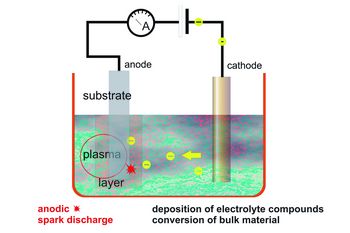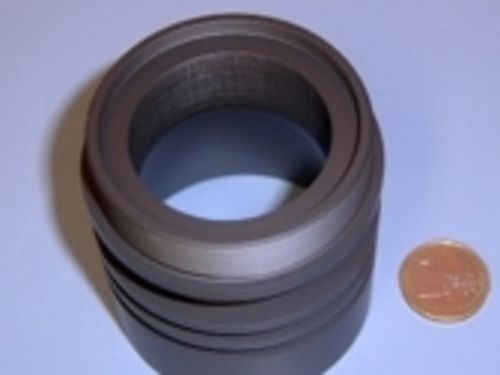Plasma Chemical Oxidation – PCO®
The light metals aluminum, titanium, magnesium and their alloys can be coated with inorganic X-ray amorphous mixed oxide layers using the plasma chemical oxidation process PCO®. In addition to oxidic compounds of the substrate material, these films also contain non-stoichiometric compounds of electrolyte ingredients with the substrate material.
PCO® Process
For synthesis of these layers, a special external current generator is used with a commercially available galvanic basin. The part to be coated is used as an anode immersing into the basin, while the counter electrode can be made of Cr-Ni steel or a similar material as the anode. The process transforms the surface into its oxides incorporating ingredients of the special electrolytes into the emerging layer by plasma discharge reactions. Thus, adjusting the electrical process parameters and the composition of the electrolytes allow the properties of the generated layers to be varied within wide limits.
Applied research and development is accomplished in Jena for more than 20 years and successful transitions of the PCO® process for industrial coating light metals is carried out for more than 10 years. This process, also known as "anodic oxidation under spark discharge" (ANOF), "anodic spark deposition" (ASD), "KEPLA-COAT®", "Plasmocer®", "Keronite" or "micro arc oxidation" (MAO) enables the formation of oxide layers with outstanding specific properties and is classified scientifically in the fields of electrochemistry and plasma physics.
PCO® Developments
By founding the workgroup “Electrochemistry” at INNOVENT in 1999, the research work on plasma chemical oxidation of light metals carried out in the Jena area was continued. With setup of appropriate laboratory equipment and analytical technology, best prerequisites have been created to be successful in this field of technology.
The focus of the work was and still is on the development plasma chemically generated layers for different substrate materials and various fields of application. New layer systems for substrates, such as magnesium alloys, were developed and are applied e.g. in optical instrument construction.
Further fields of research include the functionalization of titanium and magnesium surfaces, e.g. for medical applications, development of technologies for coating high-silicon aluminum alloys and the development of REACH and RoHS compliant electrolyte systems. Another focus of development is concentrated on the use of e.g. alternating current AC for the simultaneous coating of both electrodes.
The development of layers with clearly defined properties has already been transferred into industrial use several times. Thereby, profound knowledge in concept development of corresponding plant systems and the introduction for industrial use is available.
PCO® Applications
- Optics and laser technology
- Engineering
- Medical technology (e.g. implants)
- Aerospace
- Food industry etc.
Literature
- F. Ausserer, I. Velkavrh, J. Voyer, S. Klien, A. Diem, J. Schmidt, R. Tessadri, V. Kahlenberg: „Morphology and Tribological Behaviour of Amorphous and Crystalline Aluminum Oxide Layers“; Solid State Phenomena 2017, 267, 190–194. doi:10.4028/www.scientific.net/ssp.267.190.
- E. Kwas, J. Schmidt, M. Kunert, S. Thein: „Ceramic coatings containing calcium and phosphate on magnesium alloy MnE21“; Surface Innovations 2017, 5(4), 221–231. doi:10.1680/jsuin.17.00017.
- A. Nguyen, M. Kunert, N. Hort, C. Schrader, J. Weisser, J. Schmidt: „Cytotoxicity of the Ga-containing coatings on biodegradable magnesium alloys”; Surface Innovations 2015, 3(1), 10–19. doi:10.1680/si.13.00035.
- J. Schmidt, A. Pfuch, B. Grünler: „Plasma chemical Oxidation of Light Metal Alloys“; Metal Russia 2014, 7-8, 48–52.
- H. Rebl, B. Finke, J. Schmidt, H.S. Mohamad, R. Ihrke, C.A. Helm, J.B. Nebe: „Accelerated cell-surface interlocking on plasma polymer-modified porous ceramics“; Materials Science and Engineering: C 2016, 69, 1116–1124. doi:10.1016/j.msec.2016.08.016.
- J. Schmidt, D. Conrad: „Beschichtung von Leichtmetallen für Anwendungen in der Lasertechnik“; Galvanotechnik 2013, 104(1), 79–85.










